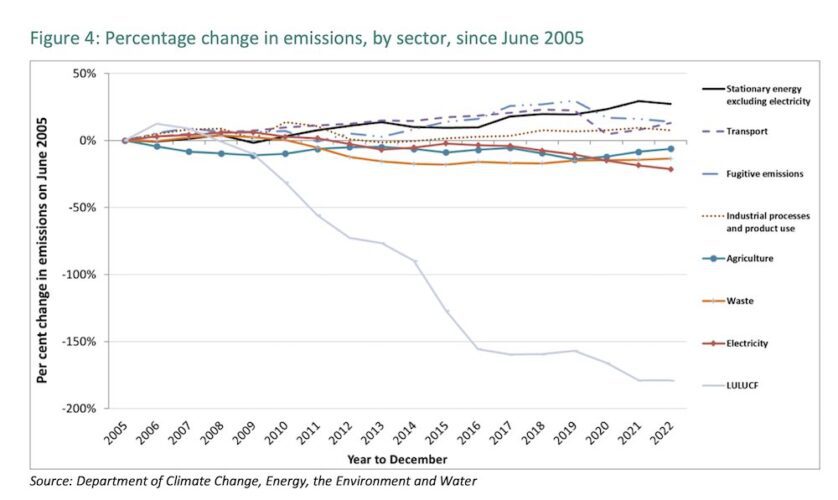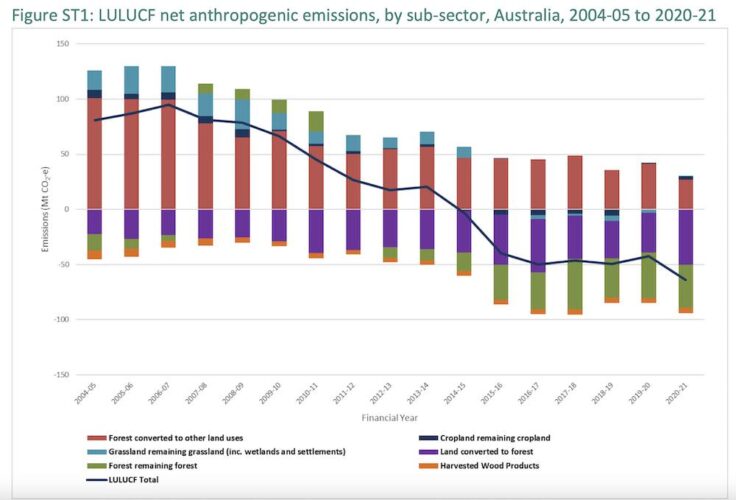Australia continues to make little progress on cutting its greenhouse gas emissions, which fell just 0.4 per cent in the 2022 year, despite solid gains made in the electricity sector where wind and solar continued to eat into the fossil fuel market.
Electricity emissions fell 3.5 per cent in 2022, and have fallen 21.4 per cent since Australia’s current emissions baseline of 2005, and 26.9 per cent since the coal power peak in 2009. It is really the only unambiguously good news story Australia has to tell about its efforts to cut emissions.
The only other industrial sector to deliver falls over the same time period is agriculture (down 6.2 per cent)., and that is because – according to the government – of reduced livestock numbers, which may in turn be the result of worsening climate conditions.
Every other industrial sector has increased emissions. The LNG boom, which has causes gas and electricity prices to soar and cripple parts of industry, has resulted in a 27 per cent surge in emissions since 2005. LNG is also responsible for a 14 per cent jump in fugitive emissions.
Transport, thanks to a huge jump in diesel consumption (Australia has become a dumping ground for big and inefficient diesel cars) has jumped 13 per cent.
All this means that Australia is in line to blow its carbon budget for 2030 – where it has set a relatively modest target of a 43 per cent cut in emissions below
According to the latest data, Australia has already eaten 27 per cent of its carbon budget in 25 per cent of the time allotted by the Paris climate treaty. And the only reason it is delivering any sort of overall reduction is because of the controversial land use calculations.
Australia set its original Kyoto target on a base year of 1990, which just so happened to be a peak year for land clearing. Its new target is set at 2005, which also happens to be a peak in land clearing. (See graph above).
In the last year it has cut down another 21,800 hectares of primary forest and another 155,000 hectares of secondary forest, its lowest rate of land clearing since satellite monitoring began in 1972.
It means that Australia can claim a reduction of 179.1% or 144.6 Mt CO2-e since 2005, through the LULUCF accounting measure, thanks also to increases in plantations and native vegetation.
That estimate may be increased by a revision to data that the government says has been distorted by a sensor in a US satellite that had “degraded in orbit and no longer provides reliable data.”
The government says that resolving this issue has resulted in LULUCF (land use) emissions being revised lower (increasing the net sink) in the period since 2014.
In the last year there have been some positive developments. The heavy rainfall caused a decline in coal mining, which helped reduce fugitive emissions by 1.7 per cent, but this might be a one off. Homes used less gas, helping cut emissions from stationary energy by 1.5 per cent.
But the biggest impact appears to be more renewables, and particularly rooftop solar, mainly because it leads to less coal generation.
The emissions intensity of the economy continued its long-term decline, down 52.1% on June 2005 levels. Emissions per capita were 42.0% lower than June 2005.
Federal energy and climate minister Chris Bowen says the latest data shows progress, but also reinforces the need for strong action on climate change and crucial policy reforms.
“Unlike the Coalition, the Albanese Government is implementing ambitious but achievable policies to decrease emissions while creating jobs and strengthening the economy,” he said in a statement.
“Our legislated emissions reduction target, Rewiring the Nation plan and landmark Capacity Investment Scheme to drive investment in cleaner, cheaper energy is working but we have much more to do.
“Reforms to the Safeguard Mechanism, developing Australia’s offshore wind and hydrogen industries, and increasing the uptake of cleaner-cheaper to run cars will help ensure we are on track to reach 43% emissions reduction by 2030 and net zero by 2050.”













